Abstract
This paper examines the propagation of M-shape solitons and their interactions with kink waves to the (2 + 1)-dimensional integrable Schwarz-Korteweg-de Vries (ISKdV) problem by applying the symbolic computation with ansatz functions technique and logarithmic transformation. The governing model usually appears in the nonlinear shallow water waves and fluid mechanics. We discuss various nonlinear waves like multiwave solutions (MSs), homoclinic breather (HB), M-shape solitons, single exponential form (one-kink), and double exponential form (two-kink). These waves have lot of applications in fluid dynamics, nonlinear optics, chemical reaction networks, biological systems, climate science, and material science. We also study interaction among M-shape solitons with kink wave. At the end, we discuss the stability characteristics of all solutions.
1. Introduction
Soliton solutions of nonlinear differential equations (NLPDEs) are a fundamental object in nonlinear sciences. The stability property of a soliton plays a crucial role in unalike mathematical and physical contexts, as it enables the persistence of coherent structures. Solitons are capable of modeling and describing a wide range of complex physical phenomena, including nonlinear optics, plasma physics, and more. Studying solitons in NLPDEs creates opportunities and mathematical challenges for thriving new analytical and numerical techniques. These characteristics advance the field of nonlinear mathematics. Several techniques for finding soliton solutions of NLPDEs have been studied during the past few decades [,,,,]. Recently, the interaction among soliton solutions has received a lot of attention from many researchers, due to their uses in biophysics, oceanography, plasma physics, and nonlinear fiber optics [,,,,,]. An extensive variety of features in soliton dynamics have been studied over the past few decades for nonlinear systems [,,,,,,,,,,,,,,]. One of the renowned NLPDEs is the Kortweg-de Vries (KdV), given as []
where the nonlinear shallow water waves are given in . The generalized form of Equation (1) is the Schwarz-Kortweg-de Vries (SKdV) equation, given as []
The component generalization of the SKdV-model in -dimensions is given as
Equation (3) was originated by Yu and Toda []. By the following assumption in Equation (3),
where , , , and are unknown functions, one can obtain
This equation is due to Pickering and Kudriashov [,,]. By the Miura transform [] on Equation (5), one can obtain
and it generates []
Many researchers worked on the ISKDV model. Ramirez et al. investigated multiple solutions for the SKDV equation in (2 + 1)-dimensions [] via Mobius transformation, Khater worked on new solitary solutions for a -dimensional ISKDV-model via the Khater technique and Bernoulli sub-equation technique [], Attia et al. studied numerical and computational solutions for a -dimensional ISKDV-model with Miura transform [], Toda et al. investigated the soliton solutions for a governing model in -dimensions [] via Lax pairs and well-known higher-dimensional manner, Gandarias et al. founded the classical symmetry reductions for the ISKDV model by using symmetries and arbitrary functions [], Li et al. studied the soliton solutions of the -dimensional ISKDV-model by applying Darboux transformation [], Li et al. evaluated the diversity soliton excitations for the -dimensional ISKDV-model [], and Aslan worked on an investigation of analytic solutions for the -dimensional ISKDV-model via improved mapping approach [], but the contribution of this document is to evaluate MS, HB, and —shaped solitons by applying the symbolic computation with ansatz functions approach and logarithmic transformation for the -dimensional ISKDV-model. M-shape rational solitons are described by nonlinear equations that involve both the phase and amplitude of the wave. They often arise in optical fibers, plasma physics, and Bose–Einstein condensates. These solitons are important because of their ability to maintain their stability and shape over long distances. Furthermore, we will study the M-shaped solitons and their interactions among one- and two-kink waves. When M-shape solitons interact, they can undergo complex dynamics. These interactions depend on the amplitudes, velocities, and phases of the solitons. They can show behaviors like fusion, elastic scattering, and bound states. The study of soliton interactions is crucial in signal processing and communication. We will also study the HBs that appear in various systems like Klein–Gordon equations, Hamiltonian systems, and optical systems. Lastly, we will also apply the stability property for attained solutions. All these stated rational solutions via the proposed method are novel and not found in the earlier literature. Our new solutions will be useful for understanding the nonlinear phenomena in the nonlinear shallow water waves and fluid mechanics.
The article template is arranged as follows. In Section 2, we will compute the MS for the -dimensional ISKdV problem with logarithmic transformation and three waves scheme. In Section 3, we will utilize the HB method and compute some new classes of solitons for the -dimensional ISKdV problem. In Section 4, we will compute the M-shaped solitons for Equation (1) and we will show some 3D, 2D, contours, and their stability profiles. The precise computation of interaction of M-shaped solitons via one exponential function approach along some 3D, 2D, contours, and their stability graphs is shown in Section 5. We will determine interactional solutions with double exponential form for the stated model in Section 6 and Section 7, and this will contain the stability property of solutions and their application to all obtained solutions (see Table 1). In Section 8, we will give results and discussions, and finally, in Section 9, we will state our concluding observations.

Table 1.
Stability properties for newly attained solutions where .
2. MS
For this purpose, we use the ansatz []
Now with usage of the logarithmic transformation in Equation (9),
we obtain
For MS, we utilize three waves ansatz on f in Equation (11) as []
where are any constants. By usage of Equations (11) and (12) and solving the equations from coefficients of cos, sinh, and cosh functions, we have
Set I.
By using the above values, we have
where and
.
Set II. When
By using the above values,
where and
.
Set III.
By using the above values, we have
where ,
,
and
.
3. HB
For HB, we consider f as follows []:
where are any constants. Inserting Equation (19) in Equation (11) and taking equations from the coefficients of exp and cos functions and by solving them, we obtain the following:
Set I. When
Via the above values, we obtain
Set II. When
Via the above values, we have
Set III. When
Via the above values, we have
4. -Shape Solitons
For obtaining the M-shape solution, we choose f in the form [,]
where are any parameters. Put f into Equation (11) and solve the system of equations, which is achieved from various coefficients of :
Set I. When ,
Using the above values, we obtain
where .
Set II. When ,
Through the above values,
Set III. When ,
Through the above values, we have
Set IV. When ,
Then we obtain
where .
5. -Shape Soliton Interaction with One Kink
For these solutions, we consider one exponential hypothesis on f [,],
where are any parameters. Put f into Equation (11) and evaluate the system of equations, which is attained from the coefficients of and functions:
Set I. When ,
We obtain
Set II. When ,
Then we obtain
6. -Shape Soliton Interaction with Two Kinks
We use the following two exponential ansatz [,]:
where , , and are some constants. By using f in Equation (11) and solving the equations obtained from the coefficients of the exponential functions, we obtain the following:
Set I.
Using the above values, we have
Set II.
Then, we have
7. Stability Characteristic of Solutions
We now evaluate the stability characteristic via Hamiltonian approach [],
Hence, the stability condition of the solutions can be evaluated as
where denotes the momentum in the Hamiltonian system, and c stands for wave velocity. The stability for Equation (28) with appropriate values of constants is given by
In the interval and , we conclude that this solution is unstable. In the same way, we check the stability of all results in the Table 1.
8. Results and Discussions
For finding numerical results, we have used the configuration of the Software MATHEMATICA:12.1 and MAPLE:14 to perform the simulation results. We have successfully obtained the stated forms of solutions and they show a discrepancy in the wave when setting the parameters to the appropriate values. First, by applying the three waves approach, we have evaluated three sets of solutions for Equation (1) and their graphs are constructed via appropriate values of involved parameters. Note that Figure 1 shows the 3D multiwave plots for in Equation (14) presented via numeric values , respectively. Figure 2 represents the 2D multiwave profiles for in Equation (14) via numeric values of . Figure 3 and Figure 4 interpret the density and stream plots for Figure 1. Furthermore, by utilizing the HB technique, we have computed three sets of solutions for Equation (1) and their plots are constructed. We have successfully evaluated the 3D HB profiles for , which are constructed with numeric values of , respectively, in Figure 5. The 2D HB plots for are displayed via numeric values of , respectively, in Figure 6. Similarly, Figure 7 and Figure 8 interpret the density and stream plots for Figure 5. We have attained four classes of M-shaped solitons via a suitable transformation in Equation (11). We have constructed M-shape evolution plots for , constructed with , in Figure 9. We have attained two classes of M-shaped solitons with one exp function via a suitable transformation in Equation (11). The resulting 3D interaction plots for are displayed with numerical values of in Figure 10 and Figure 11. Figure 12 and Figure 13 interpret the density and stream plots for Figure 10. We have computed two sets of solutions for M-shaped solitons with double exp function through a suitable transformation in Equation (11). The evolution profiles for are constructed with choice of in Figure 14. Furthermore, their stability characteristics are successfully manipulated. We believe that the results attained in this work will be helpful for recognizing rogue wave-like phenomena and many other novel interactional phenomena in shallow water waves.
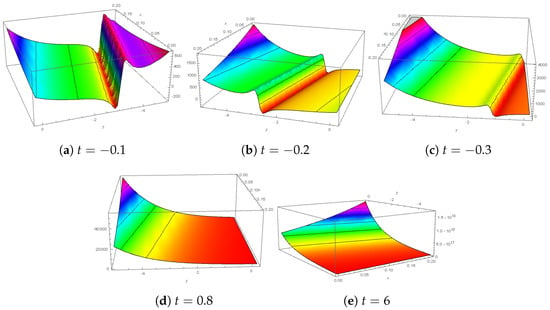
Figure 1.
3D multiwave plots for in Equation (14) are presented via .
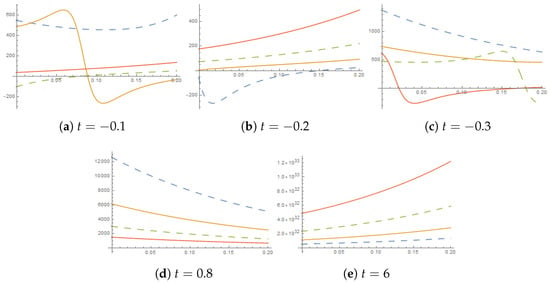
Figure 2.
2D multiwave profiles for in Equation (14) are constructed with .
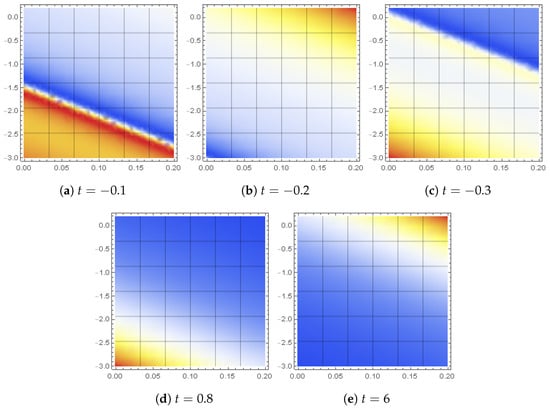
Figure 3.
Density multiwave plots for are constructed with .
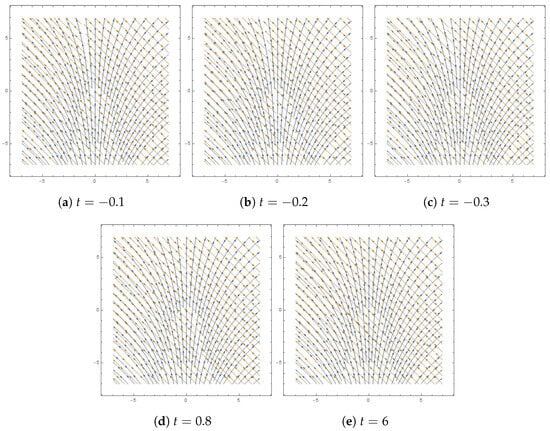
Figure 4.
Stream multiwave profiles for are constructed with .

Figure 5.
3D HB profiles for are constructed with .
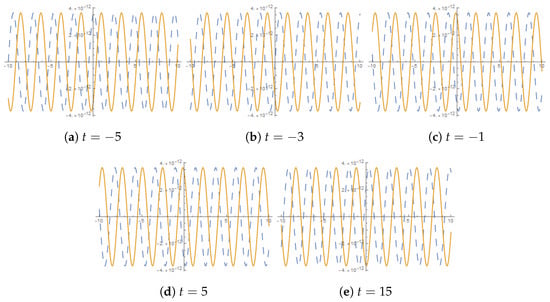
Figure 6.
2D HB plots for are displayed with .

Figure 7.
Density profiles for are constructed with .

Figure 8.
Stream plots for are constructed with .
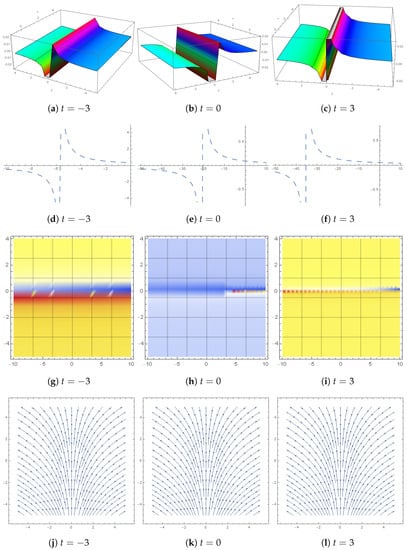
Figure 9.
M-shape evolution profiles for are constructed with .
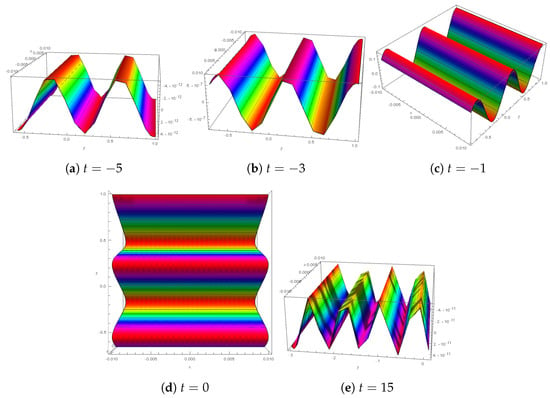
Figure 10.
3D interaction plots for are displayed with .
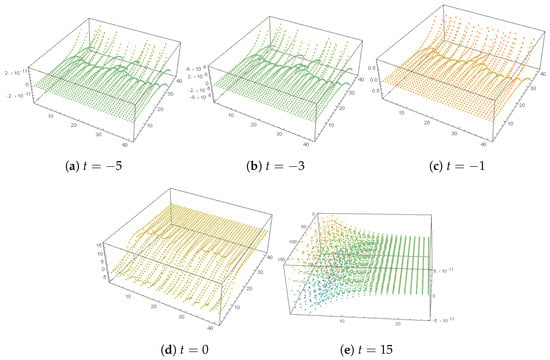
Figure 11.
Some interaction slots for are shown with .

Figure 12.
Density interaction graphs for are shown with .
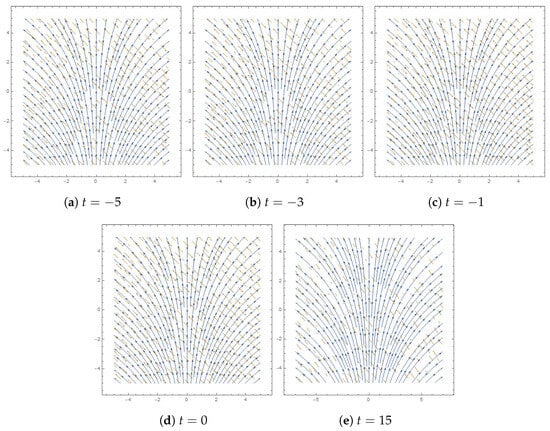
Figure 13.
Stream interaction plots for are shown with .
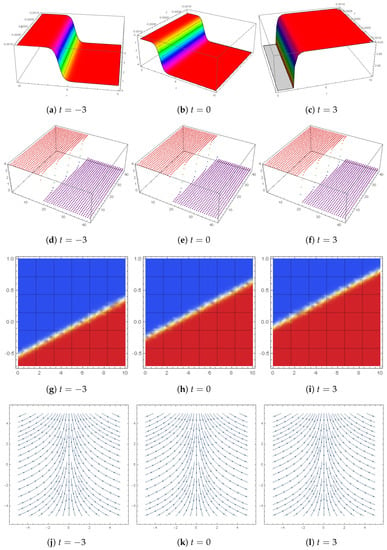
Figure 14.
Evolution profiles for are constructed with .
9. Concluding Remarks
In this article, we studied MS, HB, M-shaped solitons by utilizing the symbolic computation with ansatz functions technique and logarithmic transformation. We also discussed interactions among M-shape solitons with kink waves, like single exponential form (one-kink) and double exponential form (two-kink). These solutions may be used to manage the behavior of pulses. MS and other solutions in shallow water wave theory are valuable tools for understanding the complex dynamics of water waves in shallow environments. They contribute to the fields of environmental science, coastal engineering, and oceanography by providing insights into wave behavior and its impact on coastal areas and ecosystems. Additionally, we discuss the stability characteristics of the obtained solutions. By using the Hamilton system characteristics, we have come to the conclusion that , where , is a stable solution (see Table 2).

Table 2.
Obtained solutions where .
Author Contributions
Methodology, S.A.; Validation, U.R.; Formal analysis, S.T.R.R.; Supervision, A.R.S. All authors have read and agreed to the published version of the manuscript.
Funding
This research was funded by the Deputyship for Research and Innovation, Ministry of Education in Saudi Arabia.
Data Availability Statement
Not applicable.
Acknowledgments
The authors extend their appreciation to the Deputyship for Research and Innovation, Ministry of Education in Saudi Arabia for funding this research work through project number: 445-9-358. Furthermore, the authors would like to extend their appreciation to Taibah University for its supervision support.
Conflicts of Interest
The authors declare no conflict of interest.
References
- Akinyemi, L. Shallow ocean soliton and localized waves in extended (2 + 1)-dimensional nonlinear evolution equations. Phys. Lett. 2023, 463, 128668. [Google Scholar] [CrossRef]
- Ali, K.; Seadawy, A.R.; Ahmed, S.; Rizvi, S.T. Discussion on rational solutions for Nematicons in liquid crystals with Kerr Law. Chaos Solitons Fractals 2022, 160, 112218. [Google Scholar] [CrossRef]
- Akinyemi, L.; Morazara, E. Integrability, multi-solitons, breathers, lumps and wave interactions for generalized extended Kadomtsev–Petviashvili equation. Nonlinear Dyn. 2023, 111, 4683–4707. [Google Scholar] [CrossRef]
- Akinyemi, L.; Şenol, M.; Tasbozan, O.; Kurt, A. Multiple-solitons for generalized-dimensional conformable Korteweg-de Vries-Kadomtsev-Petviashvili equation. J. Ocean. Eng. Sci. 2022, 7, 536–542. [Google Scholar] [CrossRef]
- Seadawy, A.R.; Ahmed, S.; Rizvi, S.T.; Ali, K. Lumps, breathers, interactions and rogue wave solutions for a stochastic gene evolution in double chain deoxyribonucleic acid system. Chaos Solitons Fractals 2022, 161, 112307. [Google Scholar] [CrossRef]
- Seadawy, A.R.; Rizvi, S.T.R.; Ahmad, S.; Younis, M.; Baleanu, D. Lump, lump-one stripe, multiwave and breather solutions for the Hunter–Saxton equation. Open Phys. 2021, 19, 1–10. [Google Scholar] [CrossRef]
- Liu, Y.; Li, B.; Wazwaz, A.M. Novel high-order breathers and rogue waves in the Boussinesq equation via determinants. Int. J. Mod. Phys. 2020, 43, 3701–3715. [Google Scholar] [CrossRef]
- Arshad, M.; Seadawy, A.R.; Lu, D.; Wang, J. Travelling wave solutions of generalized coupled Zakharov-Kuznetsov and dispersive long wave equations. Results Phys. 2016, 6, 1136–1145. [Google Scholar] [CrossRef]
- Wazwaz, A.M. Multi-soliton rational solutions for some nonlinear evolution equations. J. Opt. 2022, 232, 162227. [Google Scholar]
- Triki, H.; Milovic, D.; Belic, M.; Biswas, A. Chirped femtosecond pulses in the higher-order nonlinear Schrödinger equation with non-Kerr nonlinear terms and cubic–quintic–septic nonlinearities. Optiks 2018, 326, 332–349. [Google Scholar] [CrossRef]
- Taghizadeh; Mirzazadeh, N.; Farahrooz, F. Exact solutions of the nonlinear Schrödinger equation by the first integral method. J. Math. Anal. Appl. 2011, 374, 549–553. [Google Scholar] [CrossRef]
- Chen, J.; Luan, Z.; Zhou, Q.; Alzahrani, A.K.; Biswas, A.; Liu, W. Periodic soliton interactions for higher-order nonlinear Schrödinger equation in optical fibers. Nonlinear Dyn. 2020, 100, 2817–2821. [Google Scholar] [CrossRef]
- Savaissou, N.; Gambo, B.; Rezazadeh, H.; Bekir, A.; Doka, S.Y. Exact optical solitons to the perturbed nonlinear Schrödinger equation with dual-power law of nonlinearity. Opt. Quantum Electron. 2020, 52, 318. [Google Scholar] [CrossRef]
- Kudryashov, N.A. Almost general solution of the reduced higher-order nonlinear Schrödinger equation. Optik 2021, 230, 166347. [Google Scholar] [CrossRef]
- Kudryashov, N.A. Optical solitons of the resonant nonlinear Schrödinger equation with arbitrary index. Optik 2021, 235, 166626. [Google Scholar] [CrossRef]
- Ma, G.; Zhao, J.; Zhou, Q.; Biswas, A.; Liu, W. Soliton interaction control through dispersion and nonlinear effects for the fifth-order nonlinear Schrödinger equation. Nonlinear Dyn. 2021, 106, 2479–2484. [Google Scholar] [CrossRef]
- Wang, K.J.; Wang, G.D. Variational theory and new abundant solutions to the (1+ 2)-dimensional chiral nonlinear Schrödinger equation in optics. Phys. Lett. A 2021, 412, 127588. [Google Scholar] [CrossRef]
- Mo, Y.; Ling, L.; Zeng, D. Data-driven vector soliton solutions of coupled nonlinear Schrödinger equation using a deep learning algorithm. Phys. Lett. A 2022, 421, 127739. [Google Scholar] [CrossRef]
- Jiang, C.; Cui, J.; Qian, X.; Song, S. High-order linearly implicit structure-preserving exponential integrators for the nonlinear Schrödinger equation. J. Sci. Comput. 2022, 90, 66. [Google Scholar] [CrossRef]
- Weng, W.; Zhang, G.; Zhang, M.; Zhou, Z.; Yan, Z. Semi-rational vector rogon-soliton solutions and asymptotic analysis for any n-component nonlinear Schrödinger equation with mixed boundary conditions. Phys. D Nonlinear Phenom. 2022, 432, 133150. [Google Scholar] [CrossRef]
- Nikan, O.; Avazzadeh, Z.; Rasoulizadeh, M.N. Soliton solutions of the nonlinear sine-Gordon model with Neumann boundary conditions arising in crystal dislocation theory. Nonlinear Dyn. 2021, 106, 783–813. [Google Scholar] [CrossRef]
- Asjad, M.I.; Ullah, N.; Rehman, H.; Baleanu, D. Optical solitons for conformable space-time fractional nonlinear model. J. Math. Comput. Sci. 2022, 27, 28. [Google Scholar] [CrossRef]
- Ngondiep, E. A novel three-level time-split approach for solving two-dimensional nonlinear unsteady convection-diffusion-reaction equation. J. Math. Comput. Sci. 2022, 26, 222–248. [Google Scholar] [CrossRef]
- Lax, P.D. Periodic solutions of the KdV equation. Commun. Pure Appl. Math. 1975, 28, 141–188. [Google Scholar] [CrossRef]
- Krichever, I.M.; Novikov, S.P. Holomorphic bundles over algebraic curves and non-linear equations. Russ. Math. Surv. 1980, 35, 53. [Google Scholar] [CrossRef]
- Shah, K.; Seadawy, A.R.; Arfan, M. Evaluation of one dimensional fuzzy fractional partial differential equations. Alexandria Eng. J. 2020, 59, 3347–3353. [Google Scholar] [CrossRef]
- Toda, K.; Yu, S.J. The investigation into the Schwarz–Korteweg–de Vries equation and the Schwarz derivative in (2 + 1)-dimensions. J. Math. Phys. 2000, 41, 4747–4751. [Google Scholar] [CrossRef]
- Bruzón, M.S.; Gandarias, M.L.; Muriel, C.; Ramirez, J.; Romero, F.R. Traveling-wave solutions of the Schwarz–Korteweg–de Vries equation in 2 + 1 dimensions and the Ablowitz–Kaup–Newell–Segur equation through symmetry reductions. Theor. Math. Phys. 2003, 137, 1378–1389. [Google Scholar] [CrossRef]
- Ramirez, J.; Romero, J.L.; Bruzón, M.S.; Gandarias, M.L. Multiple solutions for the Schwarzian Korteweg–de Vries equation in (2 + 1)-dimensions. Chaos Solitons Fractals 2007, 32, 682–693. [Google Scholar] [CrossRef]
- Seadawy, A.S.; Iqbal, I.; Lu, D. Applications of propagation of long-wave with dissipation and dispersion in nonlinear media via solitary wave solutions of generalized Kadomtsive-Petviashvili modified equal width dynamical equation. Comput. Math. Appl. 2019, 78, 3620–3632. [Google Scholar]
- Wang, J.; Shehzad, K.; Seadawy, A.R.; Arshad, M.; Asmat, F. Dynamic study of multi-peak solitons and other wave solutions of new coupled KdV and new coupled Zakharov-Kuznetsov systems with their stability. J. Taibah Univ. Sci. 2023, 17, 2163872. [Google Scholar] [CrossRef]
- Wang, K.J. Resonant multiple wave, periodic wave and interaction solutions of the new extended (3+1)-dimensional Boiti-Leon-Manna-Pempinelli equation. Nonlinear Dyn. 2023, 111, 16427–16439. [Google Scholar] [CrossRef]
- Gandarias, M.L.; Bruzón, M.S.; Ramirez, J. Classical symmetry reductions of the Schwarz–Korteweg–de Vries equation in 2 + 1 dimensions. Theor. Math. Phys. 2003, 134, 62–71. [Google Scholar] [CrossRef]
- Li, X.; Zhang, M. Darboux transformation and soliton solutions of the (2 + 1)-dimensional Schwarz–Korteweg–de Vries equation. Mod. Phys. Lett. B 2020, 34, 2050270. [Google Scholar] [CrossRef]
- Li, Z. Diversity soliton excitations for the (2 + 1)-dimensional Schwarzian Korteweg-de Vries equation. Therm. Sci. 2018, 22, 1781–1786. [Google Scholar] [CrossRef]
- Aslan, I. Analytic investigation of the (2 + 1)-dimensional Schwarzian Korteweg–de Vries equation for traveling wave solutions. Appl. Math. Comput. 2011, 217, 6013–6017. [Google Scholar] [CrossRef]
- Ahmed, I.; Seadawy, A.R.; Lu, D. Kinky breathers, W-shaped and multi-peak solitons interaction in (2+1)-dimensional nonlinear Schrödinger equation with Kerr law of nonlinearity. Eur. Phys. J. Plus 2019, 134, 120. [Google Scholar] [CrossRef]
- Ahmed, I.; Seadawy, A.R.; Lu, D. M-shaped rational solitons and their interaction with kink waves in the Fokas–Lenells equation. Phys. Scr. 2019, 94, 055205. [Google Scholar] [CrossRef]
Disclaimer/Publisher’s Note: The statements, opinions and data contained in all publications are solely those of the individual author(s) and contributor(s) and not of MDPI and/or the editor(s). MDPI and/or the editor(s) disclaim responsibility for any injury to people or property resulting from any ideas, methods, instructions or products referred to in the content. |
© 2023 by the authors. Licensee MDPI, Basel, Switzerland. This article is an open access article distributed under the terms and conditions of the Creative Commons Attribution (CC BY) license (https://creativecommons.org/licenses/by/4.0/).